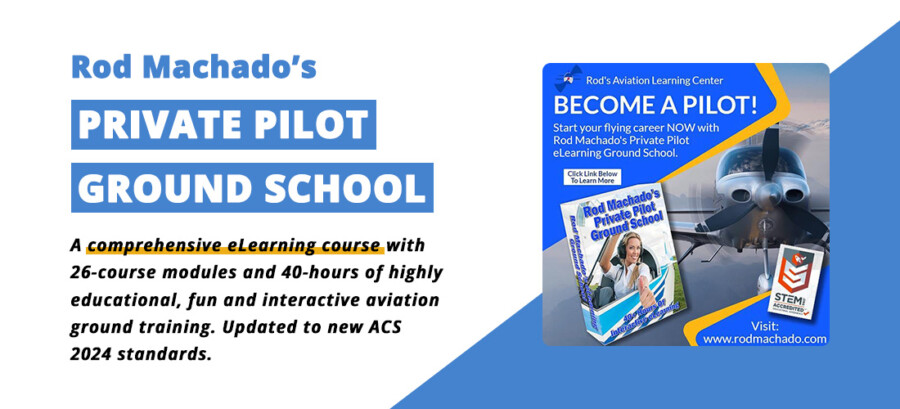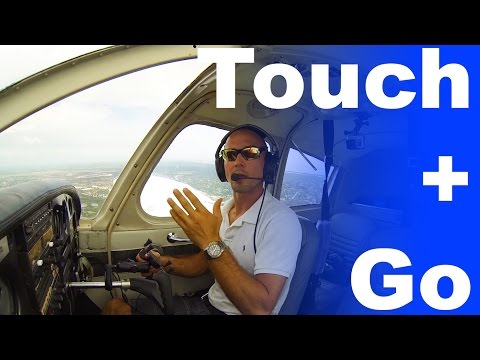What is a Touch-and-go Landing and Why do Pilots do Them?
25 March 2022 | Updated on February 05, 2024
Walking around the local airport, you may have seen small general aviation aircraft land and then immediately take off again, without coming to a full stop or exiting the runway. This type of landing is called a touch-and-go, and there are several reasons why pilots elect to do them.
in this article, we’ll discuss what a touch-and-go is, how to execute one, and some of the reasons why pilots choose to do them.


What is a Touch-and-go Landing?
In aviation, a touch-and-go landing, often abbreviated to TGL, is a maneuver that involves landing the airplane and immediately taking off again once the wheels have touched the ground, without coming to a full stop on the runway.
The pilot then usually circles the airport in a precise traffic pattern, known as a circuit, before repeating the procedure and coming in for another touch & go.
It is a common flight maneuver practiced when learning to fly an airplane.
Why do Pilots Practice Touch-and-go Landings?
The first, and most obvious reason, is that it saves time.
Since you’re not bringing the aircraft to a full stop each time you land, a touch-and-go landing allows the student pilot to practice many landings in a short time. This is an excellent way to minimize downtime and maximize airtime for a student pilot during his or her flight training.
However, it’s not only student pilots who regularly perform touch-and-go landings. Pilots of all experience levels use touch-and-goes to maintain their proficiency or to keep their skills sharp.
Also, spending an extended amount of time in the traffic pattern of an airport can be beneficial for a pilot’s situational awareness. At busy airports, traffic patterns can get congested, and it can be easy for a pilot to lose track of where he or she is in the pattern or where the other aircraft are at any given moment.
By constantly landing and taking off again, a pilot is forced to stay vigilant and focused on his or her position in the pattern, which can pay dividends down the road if the pilot ever finds himself or herself in a situation where situational awareness is critical, such as when flying in busy airspace or unfamiliar airport environments.


Another reason pilots may choose to perform touch-and-go landings is to maintain their proficiency in landing the aircraft. As with any skill, the ability to land an airplane smoothly and consistently can degrade over time if a pilot doesn’t regularly practice it, especially when flying multiple aircraft with very different flying characteristics.
Finally, in some parts of the world, aviation authorities may require pilots to perform a minimum number of landings when taking passengers with you. Both Europe (EASA) as the United States (FAA) requires any pilot to execute 3 take-offs and landings within 90 days in order to maintain the ability to legally carry passengers. This rule is also referred to as the 90-day rule.
Touch-and-go landings are a great way to efficiently and safely execute these landings in a short time, while also staying sharp on other skills such as take-offs, flying in the traffic pattern, and radio communication.
Difference Between Touch-and-go and Standard Landing Procedure
When comparing a touch-and-go to a standard landing, both procedures are very similar in the way they are executed, with two exceptions: the intention of the maneuver, and what happens after the wheels have touched the runway.
During a standard landing, the pilot’s intention is to land the airplane and taxi the aircraft to its stand, gate or parking after slowing down on the runway and exiting onto a taxiway.
During a touch-and-go, the pilot’s intention is to briefly land the airplane on the runway, after which he or she applies full power to take off again without coming to a stop. As mentioned above, this is usually with the goal of practicing circuits and landings.
What happens after the wheels have touched the ground is very different. During a regular landing, the pilot will pull back power just before he/she executes the landing flare, after which braking is applied, and potentially spoilers or thrust reverses if the aircraft is equipped with those. These are applied until the aircraft has lost sufficient speed to exit the runway safely and continue its taxi.
This is in big contrast with the way the pilot reacts after touchdown during a touch-and-go landing. Up until the point where the main wheels start to touch the runway, both maneuvers are very similar, but as soon as the aircraft has settled on the runway, the pilot will again apply full power, while simultaneously starting to pull the yoke or stick back to initiate the take-off, and (partially) retract any landing flaps that were set in the process (more on that later).


Difference Between a Touch-and-go and a Stop-and-go Landing
Another maneuver similar to a touch-and-go landing is the stop-and-go landing. During a stop-and-go landing, the pilot brings the airplane to a complete stop on the runway, before taking off again. Depending on the runway length, a stop-and-go landing may require taxiing back to the start of the runway if insufficient runway remains to take-off again, performing a maneuver called backtracking (taxiing in the runway, opposite of the take-off/landing direction).
Other Advantages of a Touch-and-go Landing
As mentioned before, the main advantage of a touch-and-go landing is that you can practice many landings in a shorter amount of time. This is due to not having to taxi back to the holding point after each landing, as you would with a full stop landing.
Another advantage, which may not be so obvious, is that it removes part of the potential hesitation you may have to execute a go-around if your landing is not up to standard. This may sound like a disadvantage at first, but it’s actually a good thing. If you were to execute a normal landing during training, and the airplane touched down too hard or too fast, you may just continue braking and bring the airplane to a full stop as intended. A touch-and-go landing, however, will allow you to be better prepared for a go-around if you don’t execute the landing correctly, as you will already be familiar with re-configuring the airplane for take-off. This is a great way to practice go-arounds, and it will also help build your confidence during landings.
Another potential advantage of touch-and-go landings is that you can use them to practice landings with different landing configurations, like different flap settings, back to back. This way, it’s easy to compare the landing characteristics of the different configurations as you perform landings with very little time in between. You can learn a lot about how an airplane behaves during the landing by doing touch-and-go landings with different flap settings, one right after another.


The Disadvantages of a Touch-and-go Landing
While touch-and-go landings are a great way to practice many landings in a short amount of time, they don’t always offer the exact same experience like a normal landing or take-off would. During a touch and go, you are not learning to bring the aircraft to a gentle complete stop, or how to vacate the runway after landing.
Also, because the take-off roll is initiated while the airplane is still rolling, this can give you a different sensation than if you were to start the take-off roll from a complete stop.
How Proper Touch & Go Landing is Performed
As mentioned earlier, the process of executing a proper touch-and-go landing starts the same as any regular landing.
After joining the traffic pattern, the pilot starts preparing for a regular landing by configuring the aircraft, making the necessary ATC radio calls, and possibly briefing the instructor or/passengers.
The approach is made at the exact same speeds, altitudes and configuration as one would with any landing, executing the flare on time and gently pulling on the stick/yoke to put the aircraft down on the runway smoothly.
Now, as soon as the wheels touch the runway, the pilot immediately starts advancing the throttle lever forward to full power and initiates the take-off roll again, keeping the aircraft straight with rudder input as the throttle is advanced. Once passing Vr, you can pull back gently on the stick and rotate the aircraft until it’s airborne again.
Depending on the specific aircraft and the landing configuration, the pilot may have set some flaps. Manual flaps can be retracted while the aircraft is rolling on the runway, making it easy to have a clean configuration again once the aircraft starts to rotate. In other cases, like with slower electronic flaps, you may only be able to partially retract them on the ground, after which you retract the remaining flaps once you have reached sufficient altitude and airspeed.
Always make sure to consult with your flight instructor about the specifics of the aircraft you’re flying!
Some additional tips for touch & go’s:
- You will spend a lot of time in the traffic pattern, make sure you announce every leg on the radio so other aircraft in the pattern, and ATC, know what you’re up to.
- Be smooth with the throttle, there is no need to ‘floor’ it during a touch & go.
- Don’t forget your checklists: it’s easy to become overly comfortable during a repetitive exercise, but before you know it you’re landing in an unsafe configuration.
- Make sure to check that the airport and runway are appropriate to perform touch-and-go landings. This means sufficient runway length and to make sure touch-and-go landings are allowed.
- Practice plenty of touch and go’s with an instructor before attempting them on your own.


How Not to Perform a Touch & Go Landing
While one can learn a lot about how to do touch & go landings by simply reading about it, another great way to learn the ins and outs of touch-and-go’s is by looking at what not to do.
Here are a few don’ts about touch-and-go landings that you should avoid at all times:
- Make sure to practice a regular landing or stop-and-go landing as well from time to time.
- When the traffic pattern is busy, make sure you don’t ‘cut in line’ by not following the standard pattern. This can be very dangerous.
- Don’t try to practice solo touch-and-go’s as a student pilot when the runway is wet or slippery, unless you’re experienced with it.
- The same goes for crosswind landings: only attempt these if you have plenty of experience or have an instructor on board.
- When practicing short and soft field landings, you should always come to a full-stop and taxi back for a full take-off.
Here’s an interesting video illustrating the basics of touch-and-go landings, executed by John from FLY8MA.com:
Do Airliners Perform Touch-and-go Landings?
Lastly, a popular question that pops up regularly is, do large commercial airline aircraft perform touch-and-go landings?
While it’s certainly not a common occurrence, the answer is yes, they do, during training. After airline pilots have performed the theoretical part of their type rating and the required simulator time, they then move on to their so-called base training, before moving on to actual line training.
During this training, new airline pilots will hand-fly their commercial aircraft around standard VFR patterns at the training airport, performing a number of touch-and-go landings. This procedure helps pilots to become familiar with taking off, flying and landing the actual aircraft, before they start flying commercially with passengers on board.
Conclusion
Touch-and-go landings are a great way to practice many landings in a short amount of time, and they offer many advantages over full-stop landings.
When performed correctly, touch-and-go landings can be a great way to improve your landing skills.
Want to learn more? Below are a few great resources you should check out!
































